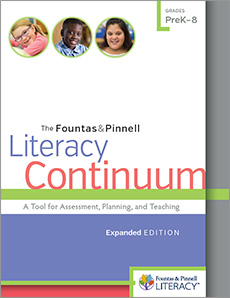Fountas & Pinnell reading levels (commonly referred to as “Fountas & Pinnell”) are a system of reading levels developed by Irene Fountas and Gay Su Pinnell to support their guided reading method.[1] Reading text is classified according to various parameters, such as word count, number of different words, number of high-frequency words, sentence length, sentence complexity, word repetitions, illustration support, etc. While classification is guided by these parameters, syllable type, an important consideration in beginning reading, is not considered as part of the leveling system. Small books containing a combination of text and illustrations are then provided to educators for each level.[2]
While young children display a wide distribution of reading skills, each level is tentatively associated with a school grade. Some schools adopt target reading levels for their pupils. This is the grade-level equivalence chart recommended by Fountas & Pinnell.[3]
| Recommended grade |
Fountas and Pinnell level |
| K |
A, B, C |
| 1 |
C, D, E, F, G, H, I |
| 2 |
I, J, K, L, M |
| 3 |
M, N, O, P |
| 4 |
P, Q, R, S |
| 5 |
S, T, U, V |
| 6 |
V, W, X, Y |
| 7 |
Y, Z |
| 8 and above |
Z |
Alternative classifications of reading difficulties have been developed by various authors (Reading Recovery levels, DRA levels, Basal Levels, Lexile Levels, etc.).

Fountas and Pinnell Reading Level Characteristics
Instructional Level: With teaching and support, the child can read the text.
Independent Level: Text the child can easily read and understand on his/her own.

The Fountas and Pinnell Assessment System in one way our district identifies a student’s reading level. The assessment provides valuable information about reading accuracy, comprehension, fluency, and more. This is just one tool used to determine your child’s strengths and weaknesses. They read a combination of fiction and nonfiction books, mistakes are recorded, and questions are asked to gauge understanding of the text. Students must be able to verbalize their thoughts for this type of assessment. An expected 1 year growth may be 3-4 levels; therefore, if they are unable to make these gains each year they will have extreme difficulty reaching the grade level expectation.
The assessments are done at…
- Beginning of the year (August-September)
- Mid-year (November-December)
- End of the year (April-May)
The assessment can…
- Determine your child’s “independent” and “instructional” reading level
- INDEPENDENT-Read with 95-99% accuracy with satisfactory comprehension
- INSTRUCTIONAL-Read with 90-94% accuracy with satisfactory comprehension
- Determine reading placement levels and group students for instruction
- Identify students who need interventions
- Assess the outcomes of teaching strategies
- Document student progress during a school year and over several years
- Inform parents of progress over a period of time
If your child is reading below grade level at this time, it’s not uncommon for them to score lower on classroom assessments. These levels have been tracked for several years; therefore, it’s unrealistic to think they can catch up to grade level in one year if they begin the year reading several levels below grade level.
The comprehension portion includes 3 types of questions, and students can score from a 1-3 in each area:
- Within the Text-Retell or summarize the story and identify the problem.
- Beyond the Text-Indicates your child’s ability to connect to their own experiences with the story and draw conclusions about characters or events.
- About the Text-Indicates your child’s ability to think about the author’s purpose, style of writing, or how the text is organized.
Self-Correction
- A self-correction rate of 1:4 means that the student corrects approximately 1 out of every 4 errors made during the reading. If a student has a rate of 1:4 or less, this indicates that he/she is self-monitoring or self-correcting his/her reading. It lets you know that they are very aware of their reading abilities.
Fluency
- Fluency is how smoothly your child reads with expression and meaning.
Accuracy Rate
- This is the percentage of words read correctly or accurately. An instructional level accuracy rate may fall between 90-100%.
Grade Level Expectations 5th Grade
Beginning of Year-Level S/T
End of Year-Level V
Anne Arundel County Public School Parents Guide to Guided Reading Levels
The site contains very valuable information regarding your child’s reading level including the characteristics of this level and strategies for helping improve your child’s reading level.
| F&P Parent Resources |
F&P Recursos de los Padres |
| Parent Guide for Levels A and B |
Guia de padres para los niveles A y B |
| Parent Guide for Levels C, D, and E |
Guia de padres para los niveles C, D, y E |
| Parent Guide for Levels F and G |
Guia de padres para los niveles F y G |
| Parent Guide for Level H and I |
Guia de padres para los niveles H y I |
| Parent Guide for J and K |
Guia de padres para los niveles J y K |
| Parent Guide for Levels L and M |
Guia de padres para los niveles L 7 M |
| Parent Guide for Levels N, O, P, and Q |
Guia de padres para los niveles N, O, P, y Q |
| Parent Guide for Levels R, S, and T |
Guia de padres para los niveles R, S, and T |
| Parent Guide for Levels U and V |
Guia de padres para los niveles U y V |
| Parent Guide for Levels W, X, Y, and Z |
Guia de padres para los niveles W, X, Y, y Z |
https://www.aacps.org/Page/2447
Book








